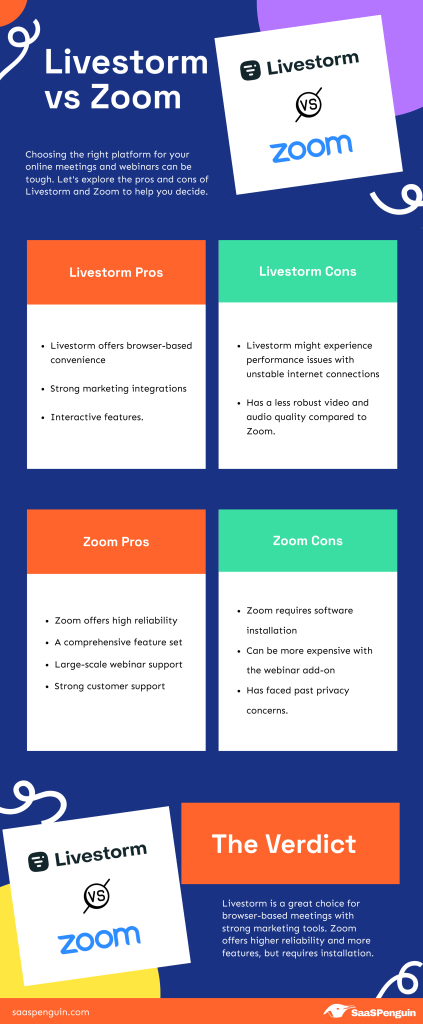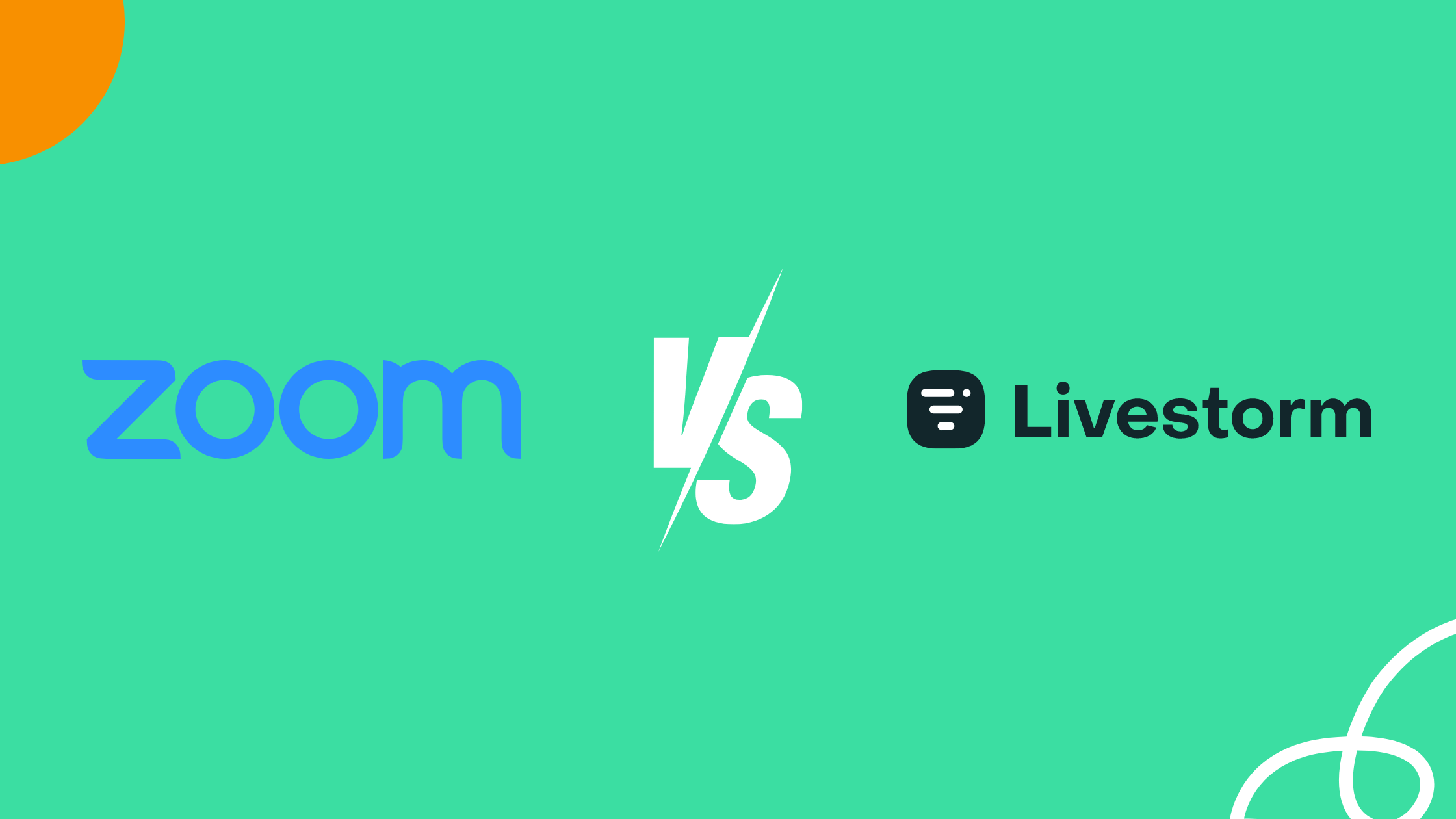Table of Contents
Livestorm vs Zoom
In today’s digital age, webinars have become an essential tool for businesses and educators alike. Whether you’re organizing a big corporate event or a small meeting, selecting the appropriate webinar platform is vital for a smooth experience. Livestorm and Zoom are two prominent names in this field. Both platforms provide robust features and are popular, but which one suits your needs? This detailed comparison will assist you in making a decision by highlighting the main differences and similarities between Livestorm and Zoom.
What is Livestorm?
Livestorm is an online webinar platform that primarily serves marketers and educators seeking a comprehensive solution for conducting live, on-demand, and automated webinars. Established in 2016, Livestorm rapidly gained popularity due to its intuitive interface and robust integration features. The platform aims to streamline the process of hosting webinars, making it user-friendly for individuals with different levels of technical skills.
Key Features of Livestorm
- Browser-Based Platform: Users can access webinars directly through their browsers without the need for downloads.
- Interactive Tools: Interactive features such as polls, Q&A sessions, chat, and question upvoting to boost audience participation.
- Automated Webinars: Plan and automate webinar sessions for regular audience engagement.
- Analytics and Reporting: Comprehensive insights on attendance, interaction levels, and feedback after webinars.
- Custom Branding: Ability to tailor the webinar interface with logos and brand colors for a personalized touch.
What is Zoom?
Zoom, a versatile video conferencing platform, has become widely popular, especially during the COVID-19 outbreak. While it is mainly recognized for its video meetings, Zoom also offers a robust webinar feature that supports large online events. Since its inception in 2011, Zoom has experienced substantial growth in its user community, emerging as one of the top tools for virtual communication globally.
Key Features of Zoom
- High-Quality Video and Audio: Offers high-definition video and audio for a clear communication experience.
- Breakout Rooms: Allows hosts to divide participants into smaller groups for focused discussions.
- Screen Sharing and Annotations: Features for presenters to share their screens and make real time annotations.
- Large-Scale Webinars: Capable of hosting webinars with up to 50,000 participants, depending on the subscription plan.
- Wide Range of Integrations: Compatible with various third-party apps and services, including CRMs, educational platforms, and productivity suites.
Ease of Use
User Interface Comparison
Livestorm and Zoom are both recognized for their user-friendly designs. Livestorm’s dashboard is clean and minimalistic, making it easy for users to navigate through different functionalities. Zoom presents a conventional setup that may seem familiar to those who are used to typical video conferencing applications.
Setup and Installation Process
Livestorm is entirely browser-based, eliminating the need for users to install any software. This offers a major benefit for those seeking a fast and hassle-free setup. In contrast, Zoom requires a brief client installation, which is usually quick but might discourage individuals who prefer a download-free experience.
Usability for Beginners
For those just starting out, Livestorm stands out as an attractive option due to its simple interface and absence of software downloads. On the other hand, Zoom, although user-friendly, comes with a wider range of features that might be a bit daunting for individuals unfamiliar with webinar platforms. However, Zoom’s comprehensive online resources play a valuable role in assisting new users in overcoming the learning curve.
Features and Functionality
Webinar Hosting Capabilities
Both platforms excel in hosting webinars, yet they differ in certain aspects. Livestorm places a strong emphasis on webinars, offering features for live, automated, and on-demand sessions. On the other hand, Zoom not only supports webinars but also caters to standard video meetings and large-scale virtual meetings.
Interactive Tools
Livestorm provides a range of interactive tools aimed at involving participants, including polls, question and answer sessions and chat options. Similarly, Zoom offers interactive elements such as Q&A, chat and polls, but extends its capabilities with features like breakout rooms and screen sharing, offering greater flexibility for various requirements.
Recording and Replay Options
While both Livestorm and Zoom offer webinar recording features, Zoom stands out with its flexibility in offering both cloud and local recording options. On the other hand, Livestorm stores its recordings in the cloud, making it simple to share them with participants through links.
Integration and Compatibility
Integration with Other Software and Tools
Livestorm seamlessly integrates with various marketing tools, CRMs and analytics platforms, making it a popular choice among marketers. On the other hand, Zoom offers extensive integrations, especially with productivity tools such as Google Workspace and Microsoft Teams, catering to corporate settings.
Compatibility with Different Operating Systems
Both platforms are compatible with major operating systems, including Windows, macOS, and Linux. Livestorm’s browser based approach ensures it functions well on any system with an internet browser, while Zoom’s dedicated applications deliver optimized performance across all platforms.
Customization Options
Livestorm provides users with the ability to personalize their webinar interfaces by incorporating branding elements such as logos and color schemes. While Zoom does offer some level of customization, especially in webinar settings, it falls short in terms of the branding flexibility that Livestorm offers.
Pricing and Plans
| Feature | Livestorm | Zoom |
|---|---|---|
| Free Plan | ||
| Participants | Up to 30 | Up to 100 |
| Session Duration | 20 minutes | 40 minutes for group meetings |
| Webinar/Meeting Capabilities | Unlimited webinars & meetings | Unlimited 1-on-1 meetings |
| Premium Plans Starting Price | ||
| Starting Price | $99/month (billed annually) | $14.99/month per user |
| Plan Types | Pro, Custom Enterprise Solutions | Pro, Business, Enterprise |
| Maximum Participants | Up to 100 (Pro Plan) | Up to 1,000 with add-ons |
| Session Limit | No limit (Pro Plan) | Up to 30 hours (Pro Plan) |
| Special Features | Customizable for enterprise needs, includes additional features like extra storage, branding | Advanced admin controls, phone support, cloud recording (1 GB per license), Zoom Phone, Zoom Rooms |
| Value for Money | Ideal for webinars and virtual events without per-user charges | Great for scalable meeting solutions with flexible add-on features |
Livestorm Pricing Overview
Livestorm offers a free plan ideal for small meetings, allowing unlimited webinars and events for a maximum of 30 participants and 20 minute sessions. Their premium packages begin at $99 per month, charged annually, supporting up to 100 participants without any time restrictions. Additionally, Livestorm offers enterprise solutions with flexible participant limits and features, along with various add-ons such as additional participants, storage, and branding options.
Zoom Pricing Overview
Zoom pricing plans consist of a free plan that permits unlimited on one meetings and group sessions lasting up to 40 minutes with a maximum of 100 participants. Premium subscriptions commence at $14.99 per month for each user, featuring extended capabilities like 30-hour group meetings and 1 GB of cloud storage for recordings. The “Business” tier, priced at $19.99 monthly per user, includes additional controls and support. Furthermore, Zoom offers supplementary services such as Zoom Phone and Zoom Rooms, which enhance functionality for larger meetings accommodating up to 1,000 participants.
Value for Money Comparison
In terms of free plans, Zoom provides more favorable conditions for extended meetings involving a larger number of participants when compared to Livestorm’s shorter sessions. On the paid side, Livestorm stands out with its straightforward flat-rate pricing for up to 100 participants, making it an economical choice for users focused on webinars without any additional charges per user. Conversely, Zoom offers greater value for larger teams seeking scalable meeting solutions, featuring pricing based on individual users and a wide range of add-on options that enhance its meeting and recording capabilities.
Security and Privacy
Livestorm Security Features
Livestorm places a strong emphasis on security by offering features such as SSL encryption, adherence to GDPR regulations, and robust data protection measures. Additionally, it provides the ability to create password-protected webinars and implement two-factor authentication for enhanced access security.
Zoom Security Features
Since early 2020, Zoom has made notable enhancements to its security features. It now provides end-to-end encryption, waiting rooms, and improved controls for meetings. While Zoom’s security measures are strong, it’s crucial for users to comprehend and correctly use the settings offered.
User Privacy Considerations
Both platforms prioritize user privacy and adhere to global regulations such as GDPR. Nonetheless, Zoom has dealt with greater public scrutiny in the past concerning privacy matters, which it has subsequently resolved by implementing stronger security protocols.
Customer Support and Resources
Livestorm Customer Support Options
Livestorm provides assistance through email support, live chat, and a detailed knowledge base. Although phone support is not offered, the available resources usually meet the needs of most users.
Zoom Customer Support Options
Zoom offers round-the-clock customer assistance via email, chat, and phone, as well as a comprehensive help center and community forum. This level of support is perfect for users who need prompt help or problem-solving.
Performance and Reliability
Livestorm Performance Metrics
Livestorm functions effectively in typical internet scenarios and is designed for optimal performance on web browsers, adjusting seamlessly to varying bandwidths. Nonetheless, being a web-based platform, it may sporadically encounter performance challenges based on the reliability of the user’s internet connection.
Zoom Performance Metrics
Zoom is well known for its dependability and performs admirably even in situations with limited bandwidth, making it a preferred choice for users with diverse internet speeds. The platform’s overall performance tends to be stronger due to its specialized application, which is more adept at managing video and audio compression.
Reliability in Different Internet Conditions
Zoom’s ability to maintain quality under different internet conditions gives it an edge, especially in scenarios where network stability is uncertain. Livestorm is reliable but may not match Zoom’s performance in fluctuating internet environments.
User Experience and Feedback
Livestorm User Reviews and Ratings
Users praise Livestorm for its ease of use, clean interface, and practical engagement tools. However, some users have reported issues with video quality and performance in unstable internet conditions.
Zoom User Reviews and Ratings
Zoom is well regarded for its flexibility, dependability, and wide range of features. Users often express frustration with the intricacy of its configurations and occasional security issues despite recent improvements.
Common Praises and Complaints
Livestorm is often commended for its simplicity and effective integration capabilities, while Zoom is recognized for its reliability and flexibility. On the other hand, some users may find Livestorm’s occasional performance hiccups and Zoom’s intricate setup to be sources of annoyance.
Use Cases and Ideal Scenarios
Best Use Cases for Livestorm
Livestorm is best for marketers, educators, and small businesses looking for a straightforward, browser-based webinar solution. Its interactive features and integration capabilities make it ideal for lead generation and educational webinars.
Best Use Cases for Zoom
Zoom excels in scenarios requiring a versatile communication tool that supports both webinars and meetings. It’s ideal for large companies, educational institutions, and any organization needing a reliable, high-quality video conferencing solution.
Industry-Specific Recommendations
When it comes to marketing and generating leads, Livestorm’s smooth integration with CRM systems is a major benefit. However, in corporate and educational settings that require high reliability and a wide range of features, Zoom stands out as the preferable option.
Pros and Cons of Livestorm

Advantages of Livestorm
- No downloads required; entirely browser-based
- Excellent integration with marketing tools
- Interactive and engagement-focused features
- Custom branding options
Disadvantages of Livestorm
- May experience performance issues under unstable internet conditions
- Less robust compared to Zoom in terms of video and audio quality
Pros and Cons of Zoom
Advantages of Zoom
- Highly reliable with solid performance across different internet conditions
- Comprehensive range of features like breakout rooms and screen-sharing
- Large-scale webinar support with up to 50,000 participants
- Strong customer support and community resources
Disadvantages of Zoom
- Requires software installation, which might be a barrier for some users
- May incur higher costs with the webinar add-on
- Has faced public scrutiny over privacy issues in the past
Livestorm vs Zoom: Which is the best for me?
Deciding between Livestorm and Zoom boils down to your individual preferences. Livestorm stands out as a great option if you want a simple-to-use platform that operates through your browser and offers robust marketing integration. However, if you require a versatile tool capable of handling both webinars and meetings with superior reliability and extensive features, Zoom is the way to go. Take into account factors like audience size, budget, and desired features when making your choice.
FAQs
u003cstrongu003eWhich platform is better for small businesses?u003c/strongu003e
For small businesses looking for an easy-to-use webinar solution, Livestorm may be more suitable due to its straightforward interface and integration with marketing tools. While Zoom is a solid choice too, it may offer more features than necessary if you don’t require its extensive capabilities.
u003cstrongu003eCan Livestorm handle large webinars?u003c/strongu003e
Yes, Livestorm can handle large webinars, though it is generally more suitable for small to medium-sized audiences. If you need to host webinars for thousands of participants, Zoom might be the better choice.
u003cstrongu003eHow does Zoom’s security compare to Livestorm’s?u003c/strongu003e
Both platforms boast strong security measures, yet Zoom has recently made notable enhancements following previous security concerns. Livestorm provides strong encryption and GDPR compliance, ensuring user data is protected.
u003cstrongu003eAre there free versions available for both platforms?u003c/strongu003e
Yes, Livestorm and Zoom both provide free versions with limited features. Livestorm’s free plan includes essential webinar functionality, while Zoom’s free tier accommodates meetings lasting up to 40 minutes with a maximum of 100 participants.
u003cstrongu003eWhich platform offers better customer support?u003c/strongu003e
Zoom generally offers more comprehensive customer support with 24/7 availability via phone, chat, and email. On the other hand, Livestorm offers support through email and chat, supplemented by a comprehensive knowledge base to assist users in navigating its features.

